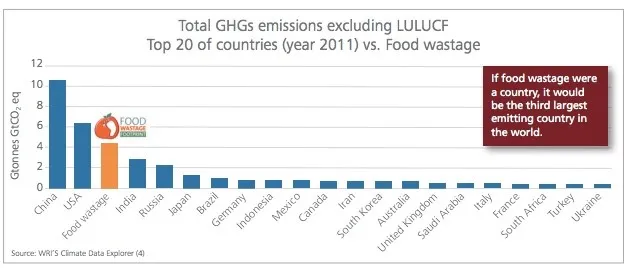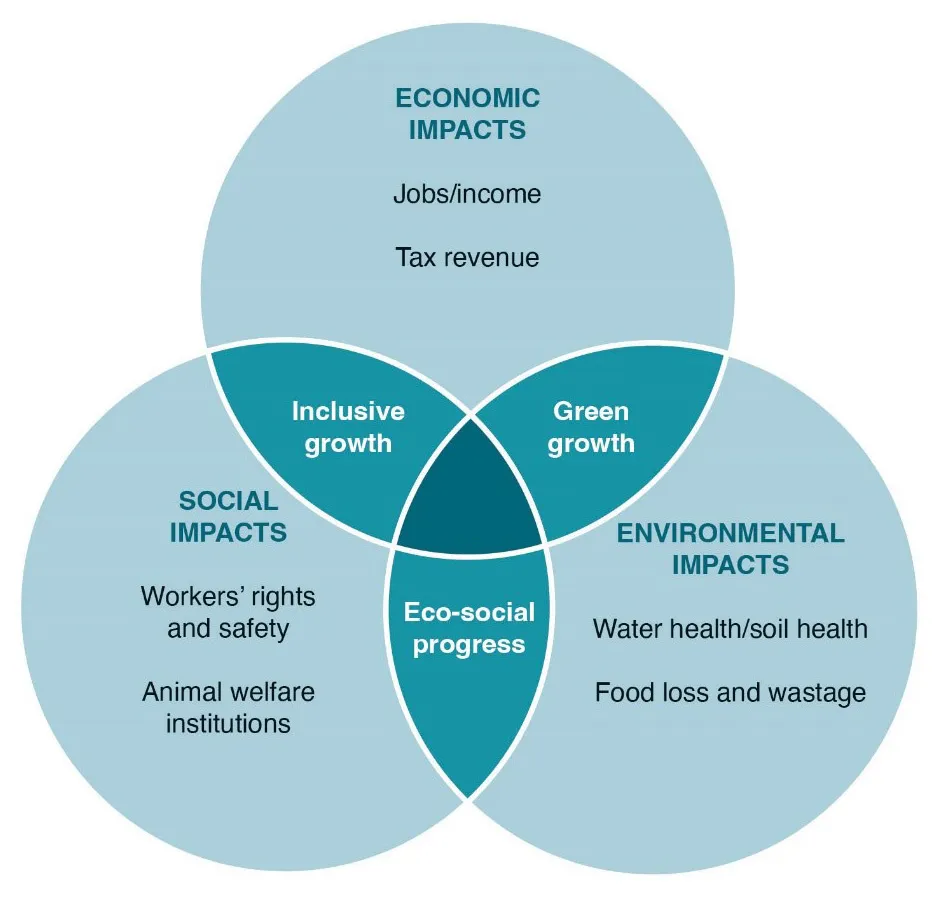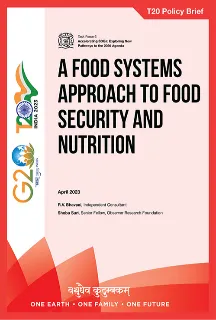1. The Challenge
The State of Food Security and Nutrition in the World 2022 report noted an increase in the prevalence of undernourishment, with hunger issues particularly concentrated in Africa (20.2 percent of the population), Asia (9.1 percent), and Latin America and the Caribbean (8.6 percent).[1] There are also great disparities within and between countries, based on socioeconomic factors. The World Inequality Report 2022 has highlighted the disparities in income and asset-holding—the richest 10 percent of the world account for 52 percent of global income and 76 percent of wealth, while the bottom half of the population accounts for just 8.5 percent of income earned and a meagre 2 percent of wealth.[2]
Even as the world has emerged from the COVID-19 pandemic in 2022, the war in Ukraine has affected economies. Climate change poses an existential threat and compounds the challenges. The pandemic threw into sharp relief the interconnectedness of the global community and the vulnerability of the poor. Today, war and conflict in one part of the world affects food prices across the globe. The poorer and less developed countries are far more affected by climate change than the wealthy and more developed nations, even though their greenhouse gas (GHG) emissions are lower than those of developed countries. Even as many countries grapple with undernutrition, increasing incidence of overweight and obesity and non-communicable diseases (NCDs) is a growing challenge. The need for more agricultural land, pastures for livestock, fertilisers and water resources to feed a growing population will have related impacts on the condition of the global environment.[3]
The Impact of Agriculture, Food Systems, and Modern Diet on the Environment
Even though the amount of food produced per person has increased by more than 30 percent since 1961, production has been characterised by excessive use of chemical inputs and water resources. It has been reported that groundwater extraction has increased from a rate of 312 km3 per year in 1960 to 734 km3 per year in 2000, while the rate of groundwater depletion has risen from 126 km3 per year to 283 km3 per year during the same period.[4] Consumption of nitrogen fertiliser has increased by 800 percent and use of irrigation water has grown by 100 percent, causing adverse consequences on the environment. Furthermore, despite the exponential growth in food production, hunger and malnutrition continue to prevail. By 2050, the world's population is projected to reach 10 billion and the need for producing enough food in a sustainable manner will only become more acute.[5]
Currently, over 800 million people across the world are undernourished, two billion adults are overweight or obese, and over two billion people are micronutrient-deficient.[a],[6] Poor eating habits and lack of nutrient-dense foods in diets are the main causes of nutrition- and obesity-related diseases worldwide. At the same time, modern agricultural practices pose a hazard to the environment because they cause anywhere from 16 percent–27 percent of the world's greenhouse gas emissions and contribute to freshwater pollution, soil erosion, and loss of biodiversity.[7] Aligning food systems to improve environment and health outcomes is one of the most pressing concerns in the 21st century.
While food production is being affected by climate change, one-third of the food produced, both on-farm and off-farm, is being lost or wasted.[8] Around 8 percent of all anthropogenic GHG emissions, or 4.4 GtCO2[b] eq, are produced each year by global food loss and waste, according to the Food and Agricultural Organization (FAO) (see Fig. 1). FAO has also emphasised that the highest carbon footprint of wastage (37 percent) occurs in the consumption phase, even though consumption accounts for only 22 percent of all food wastage. This is because wastage is said to be more carbon-intensive as one moves further along the food supply chain.[9]
According to estimates, if one-fourth of the food which is currently lost or wasted worldwide were to be saved, there would be enough food to feed 870 million people, with India having the highest percentage of those who are hungry (about 194.6 million).[10] Maximum loss of food occurs during the transit from farm to fork, especially to urban markets. These losses not only impact producers through reduced income and consumers with increased costs, but also challenge overall food security.
Fig. 1: Greenhouse Gas Emissions, by Country

Source: https://www.fao.org/3/bb144e/bb144e.pdf
The trilemma in global nutrition involves the challenge of addressing diet, health, and the environment, with awareness of their interdependence and without compromising on any one of them.[11] Three-fourths of the global disease burden are a result of the current dietary trends, and the environmental effects of diet-related illnesses have significantly increased. Diets are reported to be responsible for an 80-percent rise in the prevalence of diabetes around the world.
In 2018, more than 12 million avoidable deaths or 26 percent of all adult fatalities were attributed to inadequate diets. According to the 2021 Global Nutrition Report, diet-related mortality that could have been prevented, increased by 15 percent from 2010, outpacing the population growth rate of 10 percent.[12] The agrifood industry's focus is shifting as a result of diets that predominantly comprise cheap, highly processed foods. This has a negative impact on the environment and human health as it increases the prevalence of metabolic and nutrition-related diseases.
Impact of COVID-19
The COVID-19 crisis has further exacerbated the situation. According to Unicef, the coverage of nutrition programmes has gone down by 30 percent; the fall was as high as 75–100 percent during the lockdown phases of the pandemic. In 2020, over 149 million children under the age of five were reported to be stunted (low height for age), while 45 million were wasted (low weight for height), and 39 million were overweight.[13] Anaemia affected around one-third of reproductive-age women.[14] The ramifications, particularly of the impact of dwindling maternal and child health and nutrition support during the pandemic, are only beginning to emerge and are likely to have long-term consequences.
The pandemic also affected livelihoods; micro surveys in this regard have shown that women were more impacted than men. The interconnectedness of human, animal, and planetary health and the imperative to adopt a ‘One Health’ approach were among the lessons learnt from the experience. The challenge today is to repair the damage caused by the pandemic, build climate-resilient agrifood systems, and pave the way for more sustainable systems in the future.[15]
2. The Role of the G20
In 2021, many countries started developing national pathways to transforming food systems to accelerate progress towards the SDGs, as part of the UN Food Systems Summit.[16] Several Coalitions of Action (e.g., Zero Hunger, Climate Resilience) have emerged to steer the process. Also in 2021, the G20 countries adopted the Matera Declaration, calling on members to prioritise actions to progress towards food security and nutrition.[17]
There is no denying that resilient food systems are the edifice for sustainable food security and nutrition. This necessitates addressing the entire chain, from production, harvest, storage, and post-harvest processing to value addition, marketing, and consumption. The G20 countries can take the lead in this effort by sharing best practices, exchanging knowledge, ensuring technology and financial support, providing impetus to coalitions, and influencing policy.
The G20, with Germany in the lead, has been playing a key role in devising strategies for reducing food loss and wastage (FLW) since 2015. Under an initiative of the Meeting of Agricultural Scientists of the G20 (MACS-G20), six annual workshops on reducing FLW have taken place since 2017. Many of the G20 countries are responsible for four-fifths of GHG emissions and necessary measures are called for to reduce the same, as per commitments under COP27.[c]
3. Recommendations to the G20
Urgent measures are needed to nurture more sustainable food systems. Climate-smart agriculture (CSA) or sustainable agriculture is an integrated strategy that incorporates climate-friendly methods of raising animals and crops.[18] Adopting sustainable farming systems, putting more emphasis on healthy eating, promoting CSA, and adopting measures to lower GHG emissions along the supply chains for food production—are all strategies to address the sustainability of the overall food system.[19]
The food systems approach (see Fig. 2) addresses dimensions of economic, social, and environmental sustainability.
Fig. 2: Food Systems Approach

Source: https://www.fao.org/3/ca2079en/CA2079EN.pdf
The five action areas, outlined at the end of the UNFSS in 2021, address the social, economic, and environmental domains with the goal of moving towards sustainable food systems. These state: i) nourish all people; ii) boost nature-based solutions; iii) advance equitable livelihoods, decent work, and empowered communities; iv) build resilience to vulnerabilities, shocks, and stress; and v) accelerate the means of implementation.
The action areas are interlinked, taking into account such considerations as production of healthy and nutritious food in an environment-friendly manner is the bedrock of ‘nourishment for all’; equitable livelihoods and incomes are needed to access nutritious food; resilience to shocks and stress, both natural (e.g. earthquakes, floods) and man-made (e.g. the COVID-19 pandemic), is of paramount importance to ensure food availability and livelihoods; and the fifth action area, related to having the necessary means or resources, encompasses the other four.
There is also a need to review national dietary guidelines to make them environmentally sustainable, balancing global evidence with local contexts and equity considerations.[20]
Exemplary programmes
There are ongoing food security programmes and social safety net measures and policy initiatives that have worked well so far. These may be replicated by others for strengthening different aspects of the food system. Among the G20 countries from the Global South, Fome Zero in Brazil, the National Food Security Act (NFSA) in India, and front-of-package food labelling in Chile and Mexico are some of the examples of inclusive approaches to ensuring wellbeing for all.
India has made the ‘right to food’ a legal right by promulgating the National Food Security Act in 2013. The country has some of the largest food distribution programmes in the world, in the form of the Public Distribution System, mid-day meals (MDMs) at public schools, and supplementary nutrition for pregnant and lactating women and children zero to six years under the Integrated Child Development Services (ICDS). Promotion of nutrient-dense millets and pulses for improving nutrition is also covered under the Act. Both millets and pulses are climate-resilient, rain-fed crops that can help mitigate the climate change challenge.
Meanwhile, ‘nutrition gardens’ of fruits and vegetables are being grown in schools and their produce are incorporated into midday meals, thus facilitating intake of fresh vegetables. A national nutrition mission (Poshan Abhiyan) is in place to address malnutrition as a priority and move towards SDG 2 (zero hunger). A study, using nationally representative data on mothers and their children over two decades, found that from 2006 to 2016, MDM was associated with 13 percent–32 percent of the height for age Z-score (HAZ) improvement among children.[21] Similar evidence on improved height and weight was found while comparing a cohort of children, aged 10–13 years, who had been fully exposed to the ICDS scheme during the first three years of life, with a cohort that had not been exposed to the ICDS during the same period of life.[22]
Along similar lines, Brazil’s Fome Zero programme, launched in 2004, was characterised by three pillars. These include (i) the Bolsa Família (family allowance) cash transfer programme for low-income families; (ii) a national school nutrition programme; and (iii) subsidies for agricultural families. Reduction in poverty, hunger and undernutrition was seen in the first decade of the century.[23]
Food labelling is another useful public health strategy, aimed at warning consumers against the dangers of unhealthy foods such as ultra-processed foods that are high in salt, sugar and trans fats. Countries such as Chile and Mexico have introduced food-labelling measures.
A study in Mexico has found that the measures, introduced in 2020, can challenge the false health and nutrition claims made by processed and ultra-processed food brands and improve levels of consumer information and awareness.[24] A study in Chile, following up on the implementation of the front-of-package warning labels in 2016, found that overall purchase of foods rich in calories, sugar, saturated fats, and sodium had significantly decreased, compared with a scenario of not having such measure.[25]
Bangladesh, meanwhile—a highly climate-vulnerable country and a guest country of the G20—has launched the Mujib Climate Prosperity Plan to move from vulnerability to resilience to prosperity.[26] The plan seeks to equip vulnerable populations, through effective financing tools and models to better manage risks and become resilient. This can be a model for other climate-vulnerable countries to counter the climate challenge.
These approaches highlight the importance of political commitment and governance in addressing food insecurity and are useful examples for other countries, especially in South Asia, Africa and Latin America and the Caribbean, facing similar issues.
Investment in tackling malnutrition in all its forms has to be high on the G20 agenda to realise the SDGs. This calls for commensurate increase in health expenditure, public health and nutrition awareness strategies incorporating sustainability, and a gender-inclusive approach, investment in technology and its effective use, and regulatory measures, such as food labelling.
Key Recommendations
- Put in place mechanisms for sustainable transformation of food systems to accelerate progress towards the SDGs, as committed to under the five action areas of the UNFSS: nourish all people; encourage nature-based solutions; promote fair livelihoods, respectable employment and empowered communities; increase resistance to shocks, pressure and vulnerabilities; and accelerate the means of implementation.
- Foster inter-country cooperation, particularly South-South and triangular, based on the evidence of the interventions that have worked to accelerate progress towards the SDGs.
- Promote adoption of ‘Lifestyle for Environment (LiFE)’ and ‘One Health’ approaches with necessary adaptation to local country contexts to ensure a new deal for People, Planet and Prosperity, in line with the focus of the UNFSS.
- Fulfil climate finance commitments under the Paris Agreement and make resources available to accelerate the means of implementation of sustainable food systems across the globe.
- Revise national dietary guidelines in line with the scientific understanding of healthy and sustainable diets and promote appropriate public health and nutrition strategies.
- Demonstrate greater technical collaboration and knowledge-sharing to facilitate transfer of technology and adoption of best practices; take the lead in Coalitions of Action under the UNFSS.
Endnotes
[a] Malnutrition is defined as a state of undernutrition or overnutrition and/or micronutrient deficiency (also referred to as ‘hidden hunger’).
[b] One billion tonnes of carbon dioxide.
[1] FAO, IFAD, UNICEF, WFP and WHO, “The State of Food Security and Nutrition in the World 2022. Repurposing Food and Agricultural Policies to Make Healthy Diets More Affordable,” 2022.
[2] L. Chancel et al. “World Inequality Report 2022,” World Inequality Lab, wir2022.wid.world.
[3] Shoba Suri and Subhasree Ray, “Building Climate-Resilient Food Systems,” Observer Research Foundation, ORF Issue Brief No. 566, August 2022.
[4] Yoshihide Wada et al., “Global Depletion of Groundwater Resources,” Geophysical Research Letters 37, no. 20 (2010).
[5] FAO, IFAD, UNICEF, WFP and WHO, “The State of Food Security and Nutrition in the World 2022”
[6] FAO, IFAD, UNICEF, WFP and WHO, “The State of Food Security and Nutrition in the World 2022”
[7] “Summary for Policymakers,” Climate Change and Land: An IPCC Special Report on Climate Change, Desertification, Land Degradation, Sustainable Land Management, Food Security, and Greenhouse Gas Fluxes in Terrestrial Ecosystems, 2019.
[8] Joseph Poore et al., “Reducing Food’s Environmental Impacts Through Producers and Consumers,” Science 360 (2018): 987-992.
[9] Food and Agriculture Organization, “Food Wastage Footprint & Climate Change,” 2015.
[10] Mucahit Turetken, “One-Fourth of Wasted Food Could Feed 870 Million People: Expert,” Anadolu Agency, January 27, 2021.
[11] Michael Clark et al., “The Diet, Health, and Environment Trilemma,” Annual Reviews 43 (2018): 109-134.
[12] “2021 Global Nutrition Report: The State of Global Nutrition,” Development Initiatives.
[13] UNICEF, “Tackling the Situation of Children During Covid-19,” November 2021.
[14] World Health Organization, “Anaemia,” 2021.
[15] World Health Organization, “UN Report: Pandemic Year Marked by Spike in World Hunger,” July 12, 2021.
[16] United Nations, “The Food Systems Summit,” September 23, 2021.
[17] “Matera Declaration on Food Security, Nutrition and Food Systems. A Call to Action in the Time of the Covid-19 Pandemic and Beyond,” G20.
[18] Food and Agricultural Organization, “Climate-Smart Agriculture”.
[19] Food and Agriculture Organization, “Sustainable Food Systems: Concept and Framework,” 2021.
[20] Renzo R. Guinto et al., “Health Sector Solutions for Promoting Sustainable and Nutritious Diets,” BMJ 378 (2022).
[21] Suman Chakrabarti et al., “Intergenerational Nutrition Benefits of India’s National School Feeding Program,” Nature Communications 12, no. 1 (2021): 4248.
[22] Gaurav Dhamija et al., “Lasting Impact of Early Life Interventions: Evidence from India’s Integrated Child Development Services,” The Journal of Development Studies 57, no. 1 (2021): 106-138.
[23] “The Fome Zero (Zero Hunger) Program: The Brazilian Experience,” FAO, 2010.
[24] Carlos Cruz-Casarrubias et al., “Estimated Effects of the Implementation of the Mexican Warning Labels Regulation on the Use of Health and Nutrition Claims on Packaged Foods,” International Journal of Behavioral Nutrition and Physical Activity 18, no. 1 (2021): 1-12.
[25] Lindsey Smith Taillie et al., “Changes in Food Purchases After the Chilean Policies on Food Labelling, Marketing, and Sales in Schools: A Before and After Study,” The Lancet Planetary Health 5, no. 8 (2021): e526-e533.
[26] “Mujib Climate Prosperity Plan 2030,” December 2021.
The views expressed above belong to the author(s). ORF research and analyses now available on Telegram! Click here to access our curated content — blogs, longforms and interviews.

 PDF Download
PDF Download









